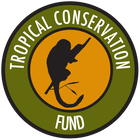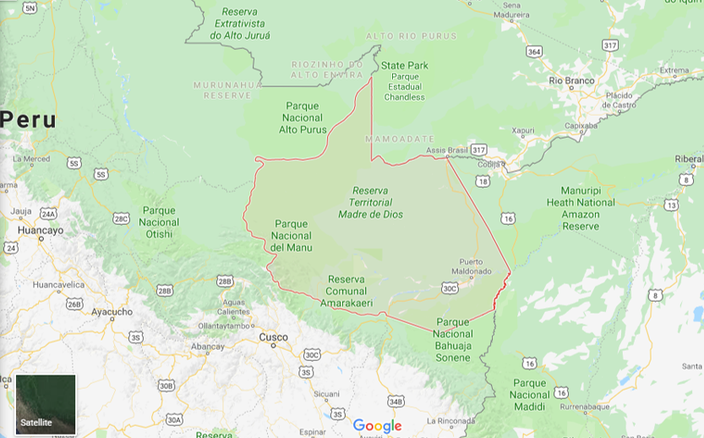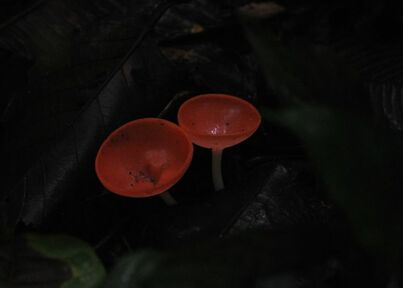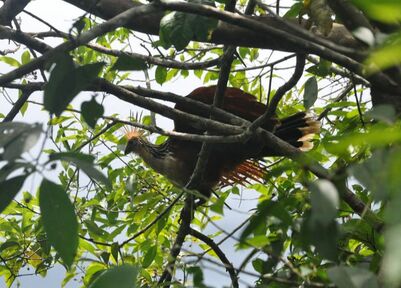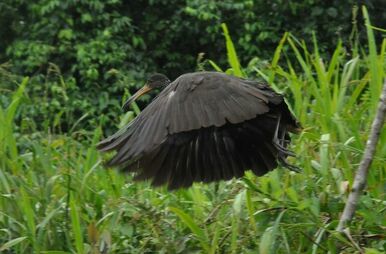 Limpkin (Aramus guarauna) photographed at Machuwasi Lake.
Limpkin (Aramus guarauna) photographed at Machuwasi Lake.
Highlights
- Travel down from the snow-capped Andes Mountains to the Amazon rainforest
- Visit Manu National Park
- See an incredible diversity of wildlife including hundreds of bird species
- Home of jaguars, giant river otters, anacondas, and some of the biggest trees in the world
- Take boat trips down the Alto Madre de Dios River which eventually feeds the Amazon river
- Canopy walkways and viewing platforms
- Indigenous communities both in the highlands and lowlands
Madre de Dios (Mother of God) is a region in southeastern Peru, bordering Brazil, Bolivia and the Peruvian regions of Puno, Cusco and Ucayali, in the Amazon Basin. Its capital is the city of Puerto Maldonado. The name of the region is derived from the Madre de Dios River, ultimately a tributary of the Amazon.
The Tropical Conservation Fund works in two different regions of the Madre de Dios. The first is accessed via a harrowing road starting from Cusco and traveling along the Manu National Park border to the Kosnipata region, while the other is accessed via the Transoceanic highway to Puerto Maldanado. This page focuses on the Kosnipata route where our April expeditions take place. We also offer trips in August to the Puerto Maldonado region. Other arrangements can be made for prearranged groups. Visit our expeditions page for more information.
The Tropical Conservation Fund works in two different regions of the Madre de Dios. The first is accessed via a harrowing road starting from Cusco and traveling along the Manu National Park border to the Kosnipata region, while the other is accessed via the Transoceanic highway to Puerto Maldanado. This page focuses on the Kosnipata route where our April expeditions take place. We also offer trips in August to the Puerto Maldonado region. Other arrangements can be made for prearranged groups. Visit our expeditions page for more information.
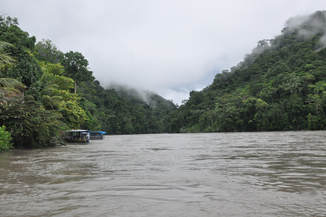
The area is notable for many different reasons. First, the Madre de Dios is dominated by lowland Amazonian rainforest which harbors incredible biodiversity, some of the largest tracts of primary forest protected by a network of areas such as Manu National Park, Amarakaeri Communal Reserve, and Tambopata National Reserve. And, the area is home to an unknown number of uncontacted indigenous communities. Due to the vast size of the area and its low population density, rivers provide the best way of getting from one town to another. For examples of what you might see in this area, follow us on Instagram at Tropical Conservation Fund or check out videos from some of our expeditions at Tropical Conservation, Travel, and Adventure.
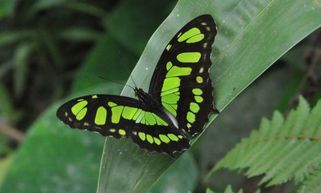
Recently, Manu National Park was designated the top biodiversity site in the entire world. A prime driver of this species richness is the elevational diversity gradient that runs from the Andes mountains down to lowland rainforest. This creates ecological niches and a vast array of ecosystems which drive speciation. What makes this place truly remarkable is that much of it remains intact despite encroaching logging, small-scale agriculture, oil exploration, gas extraction, and gold mining. Manu National Park has three designated zones which are in place to protect the environment and the people: a cultural zone, a reserved zone, and the restricted zone. Anyone can enter the cultural zone on their own. There are several indigenous communities that can be visited by tourists. The reserved zone can only be assessed by permit with a tour group. Here you can find primary forest, research stations, and a few ecotourism sites. The restricted zone does not allow tourists and even park rangers do not enter this area because of the unknown number of uncontacted tribes living inside. If interested in visiting this area, we can help organize a sustainable, eco-friendly trip for you.
For those interested in nature, this is your place. For researchers who want to conduct research in minimally impacted rainforest with broad ecological diversity, this your place. For those who are adventure seekers - few places elsewhere will rival this wild landscape. Whether you're traveling on a budget or whether you want to stay at premier jungle lodges, the Madre de Dios region has what you are looking for. Many travelers also couple this experience with time spent in Cusco, the Sacred Valley, and Machu Picchu.
Field Stations, Lodges,and Conservation Projects (Kosnipata Entrance)
A note about this entrance into the Madre de Dios region. The road is far less developed than the Transoceanic Highway through Puerto Maldanado. As a result, there are sometimes landslides which make travel difficult in the rainy season (November until March). This doesn't limit your travel to the dry season - and in fact, you may want to go during the wet season to maximize the true rainforest experience - but you should note that the road can be difficult at times depending on weather. You can take public transport, but there is definitely a risk if you don't travel with a group. There are numerous travel groups that will provide safe transportation and guides, including the Tropical Conservation Fund. The cost varies significantly depending on accommodations, where you want to go, and whether you want to enter the park since permits are required.
The Kosnipata Entrance takes you down the Andean slopes and into lowland rainforest. Here, you'll travel along the outer edge of the Manu National Park and travel deeper into the Amazon will be primarily by chartered boats.
For those interested in nature, this is your place. For researchers who want to conduct research in minimally impacted rainforest with broad ecological diversity, this your place. For those who are adventure seekers - few places elsewhere will rival this wild landscape. Whether you're traveling on a budget or whether you want to stay at premier jungle lodges, the Madre de Dios region has what you are looking for. Many travelers also couple this experience with time spent in Cusco, the Sacred Valley, and Machu Picchu.
Field Stations, Lodges,and Conservation Projects (Kosnipata Entrance)
A note about this entrance into the Madre de Dios region. The road is far less developed than the Transoceanic Highway through Puerto Maldanado. As a result, there are sometimes landslides which make travel difficult in the rainy season (November until March). This doesn't limit your travel to the dry season - and in fact, you may want to go during the wet season to maximize the true rainforest experience - but you should note that the road can be difficult at times depending on weather. You can take public transport, but there is definitely a risk if you don't travel with a group. There are numerous travel groups that will provide safe transportation and guides, including the Tropical Conservation Fund. The cost varies significantly depending on accommodations, where you want to go, and whether you want to enter the park since permits are required.
The Kosnipata Entrance takes you down the Andean slopes and into lowland rainforest. Here, you'll travel along the outer edge of the Manu National Park and travel deeper into the Amazon will be primarily by chartered boats.
- Wayqecha (Amazon Conservation Association) - This cloud forest field station is stunning. At 2000-3010 m (6,500-9,875 ft), this site is at the doorstep to the lowland rainforest below. The high elevation makes it relatively cool, with clouds often passing through as they move up the valley. This is station is home to the Andean spectacled bear (Tremarctos ornatus), a remarkable display of orchids, and a unique set of birds and amphibians. Cabins are available along with dormitory style quarters for researchers and students. A canopy walkway gives you a breathtaking view of the upper canopy of a cloud forest.
- Cock-of-the-Rock Lodge (Rainforest Alliance) - This lodge is adjacent to Manu National Park. The Rainforest Alliance has a private conservation area with 12,350 acres (5,000 ha) of cloud forest at 1,100 to 2,700 m (3,609 to 8,858 ft). The reserve provides habitat for Peru’s national bird, the cock of the rock (Rupicola peruviana) and includes a lek where males are often found displaying for females. The Andean toucan (Andigena hypoglauca) is also found here. This area protects the spectacled bear and at least three species of monkeys. Cabins are available along with a camping platform for researchers.
- Reserva Tierra Linda - Accessible station adjacent to Manu National Park. Accommodations are affordable and rustic.
- Villa Carmen Biological Station (Amazon Conservation Association) - Villa Carmen is located on over 7,500 acres (3035 ha) of land within Manu Biosphere Reserve. Spanning an elevational gradient from 500 to 1200 m (1,700 to 4,000 ft), Villa Carmen hosts an incredible array of species found in a variety of habitats, ranging from cloud forest to montane and lowland rainforest.
- Machuwasi Lake - You can walk to this protected area just outside of Salvacion. The forest is fairly intact, especially considering it is so close to town. Wooden rafts are available for a small fee which can be used to float around and observe an array of birds.
- Manu Learning Center (Crees) - The field station attracts scientists, conservationists, volunteers and tourists. Long-term accommodations are available for volunteers as they conduct research and surveys of the rainforest surrounding the center.
- Romero Refugio (Crees) - This lodge is only accessible by boat as it is found upriver from Boca Manu in Manu National Park. Arrangements can be made online or through the Manu Learning Center. The surrounding forest is stunning and the accommodations are catered towards tourists. Permits required for entrance into the park.
- Cochu Cashu Biological Station - This station is a tropical ecology field station located in Manu National Park. Cocha Cashu is situated well inside Manu National Park and minimally impacted by man, providing critical insights into the biodiversity and processes of a healthy, intact rainforest. Permits required for entrance into the park.
- Manu Birding Lodge - Primarily focused on the birding community, with maintained grounds and trails. Accommodation is basic but comfortable. One building has built-in modern showers, the other had showers located at the end of the building. Electricity and hot water provided. Nearby clay lick and oxbow lake.
- Manu Wildlife Center - This lodge is spectacular and primarily focused on tourism. The forest is stunning with a grid trail system and a tree canopy platform. You can only access the center by boat, either coming from Salvacion, or from Puerto Maldanado.
- Los Amigos Biological Station - CICRA (Amazon Conservation Association) - Primarily a site for scientists and conservationists. The station is located on 1119 acres (453 ha) of lowland rainforest with a network of trails, and also includes an adjoining 360,000 acres (145687 ha) as part of the Los Amigos Conservation Concession (LACC).
Wildlife, Flora, and Unique Ecosystems
Manu National Park is a massive protected area encompassing 2 million hectares (20,000 km2). The area is home to a staggering variety of plant and animal species, including giant otters, capybaras, peccaries, tapirs, jaguars, caiman, 13 different species of monkeys, over 1000 species of birds and over 1300 species of butterflies. All together there have been over 4,000 animal species described and over 20,000 types of plants.
Manu National Park is a massive protected area encompassing 2 million hectares (20,000 km2). The area is home to a staggering variety of plant and animal species, including giant otters, capybaras, peccaries, tapirs, jaguars, caiman, 13 different species of monkeys, over 1000 species of birds and over 1300 species of butterflies. All together there have been over 4,000 animal species described and over 20,000 types of plants.
|
|
|
Species Lists
iNaturalist CheckList - Manu National Park (All taxa)
iNaturalist Checklist - Manu Learning Center (All taxa)
iNaturalist CheckList - Manu National Park (All taxa)
iNaturalist Checklist - Manu Learning Center (All taxa)
